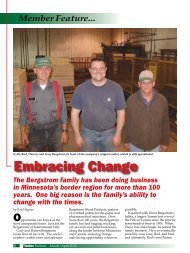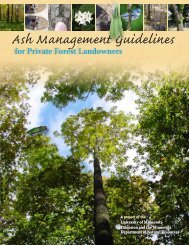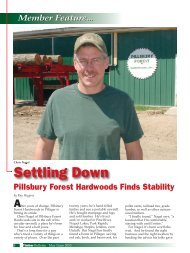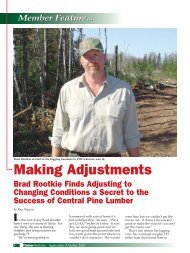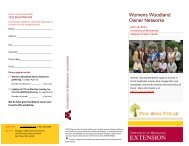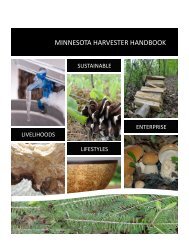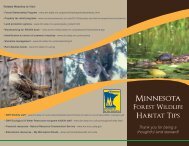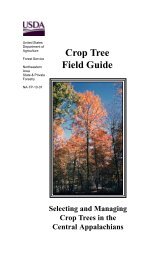Ash Management Guide for Private Forest Landowners
Ash Management Guide for Private Forest Landowners
Ash Management Guide for Private Forest Landowners
Create successful ePaper yourself
Turn your PDF publications into a flip-book with our unique Google optimized e-Paper software.
AppendicesAppendix A<strong>Guide</strong>lines <strong>for</strong> managing sites with ashto address the threat of emerald ash boreron DNR <strong>Forest</strong>ry-administered landsBACKGROUNDThe ash genus (Fraxinus) in Minnesota comprises some900 million trees and is the second most common hardwoodtree genus in the state. EAB was discovered in the United Statesin 2002 and is now present in 13 states and 2 Canadian Provinces.It was found in Minnesota in 2009. EAB populations canspread rapidly in infested firewood, logs, and ash nursery stock.There<strong>for</strong>e, it is assumed that EAB will soon infest Minnesota’s<strong>for</strong>ested areas and cause significant impact to the ash resource.Experience from other states has shown that EAB kills 99+% ofthe ash in a stand once that stand becomes infested. This levelof impact is greater than what occurred with American elm followingthe introduction of Dutch elm disease to Minnesota.To date there has been no evidence of resistance to EABwithin any North American ash species. Resistance does existin some Asian ash species. Subtle differences in susceptibility toEAB between white, green, and black ash have been reported,but those differences are minor and should not influence managementoptions. All three ash species in Minnesota will likelysuccumb to EAB attack.SCOPEThis document applies to:• <strong>Forest</strong>ed stands classified as ash covertype• <strong>Forest</strong>ed stands with an ash component of at least 20% ofstand basal area but not typed as an ash covertype. Nativeplant communities where ash is and can be significantinclude: FDw44, MHs49, MHw36, MHc47, MHn46, FFs58,FFs59, FFn57, FFn67, WFs57, WFw54, WFn53, WFn55,WFn64.• <strong>Forest</strong>ed stands with ash that are free of EAB occurrenceand are greater than 25 miles from the closest known EABinfestation. This distance will allow multiple entries into astand based on an average, “natural” movement of EAB of~2 miles per year.ASH MANAGEMENT OBJECTIVES• Landscape perspective: Manage ash populations in thelandscape to protect sensitive wetland ecotypes, reduceoutbreak costs, and restrict emerald ash borer introductionand spread without eliminating ash within <strong>for</strong>est ecosystems.• Stand perspective: Create conditions that will reducepotential impacts and increase the resiliency of <strong>for</strong>estedstands by• Keeping <strong>for</strong>ested sites <strong>for</strong>ested• Maintaining an ash component but reducing the size andnumber of ash in the stand.• Increasing tree species diversity.• <strong>Management</strong> objectives should focus on ecosystem healthand management, not on the emerald ash borer. The intentis to limit habitat attractiveness to EAB.• The Division of <strong>Forest</strong>ry will work within its nurseryprogram and with other partners <strong>for</strong> maintainingrepresentative samples of genotypes but not <strong>for</strong> processingseeds <strong>for</strong> re<strong>for</strong>estation.CAVEATS• There is a likelihood that the vast majority of ash trees inMinnesota will be killed by EAB regardless of the type ormagnitude of actions taken.• The large extent of the ash resource, particularly black ash,will likely mean that sufficient management actions will notoccur in all stands prior to EAB becoming established inMinnesota. <strong>Forest</strong>ed sites will be altered or lost.• Little is known through research and experience how tomaintain black ash <strong>for</strong>ested sites as <strong>for</strong>ested communitiesonce the black ash is killed or removed. On-going researchand knowledge gained through experience that can bepassed along to all managers will be critical to meeting longterm ash management objectives. There<strong>for</strong>e, this documentpresents interim guidance that will change as knowledgefrom research and experience is gained.Managing <strong>for</strong>ested stands with ash• INTERIM DIRECTIVE FOR ALL STANDS WITH ASHThe current scientific evidence does not support investmentsin artificial regeneration of ash species or managementpractices implemented to expand or regenerate ashpopulations. These activities could also compromise ef<strong>for</strong>ts toprotect sensitive wetland ecosystems through canopydiversification, reduce <strong>for</strong>est vulnerability and potentiallycompromise EAB response ef<strong>for</strong>ts.• <strong>Ash</strong> species should not be planted on DNR administeredlands <strong>for</strong> ornamental, shade or re<strong>for</strong>estation purposes. Inimplementing <strong>for</strong>est management practices do not structureoperations to intentionally favor the regeneration orreestablishment of ash.• Rationale: In order to avoid perpetuating habitat <strong>for</strong> EAB<strong>for</strong> future generations, the current objective is to diversify ashdominated plant communities now and into the near future.• Actions• Do NOT plant ash seedlings on state administered lands orrecommend ash seedlings <strong>for</strong> re<strong>for</strong>estation on private lands.• Do NOT use ash seed in the mix <strong>for</strong> direct seeding on stateadministered lands or recommend ash seeds <strong>for</strong> direct seedingon private lands.60



